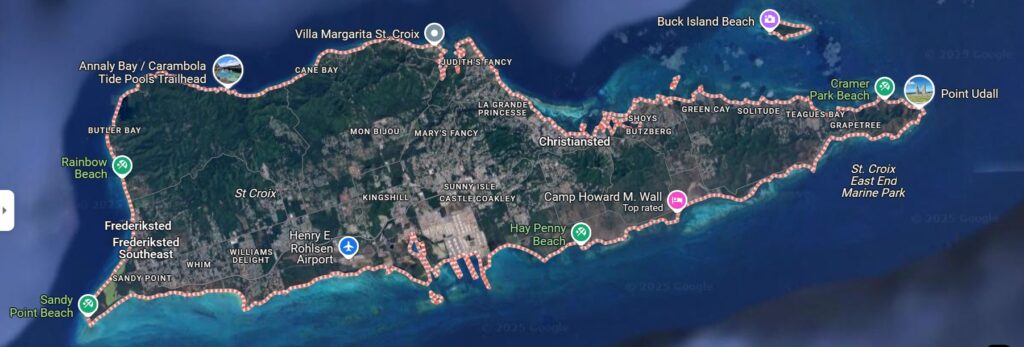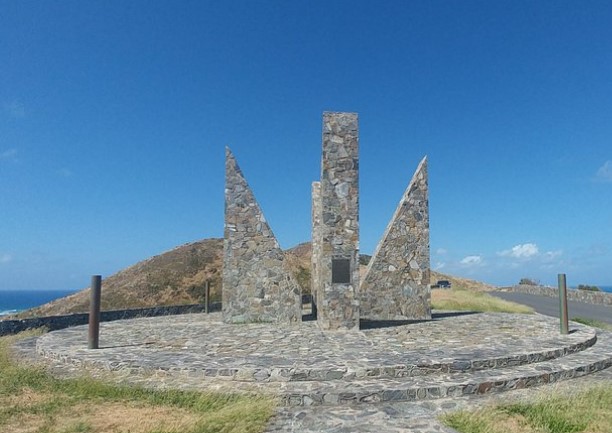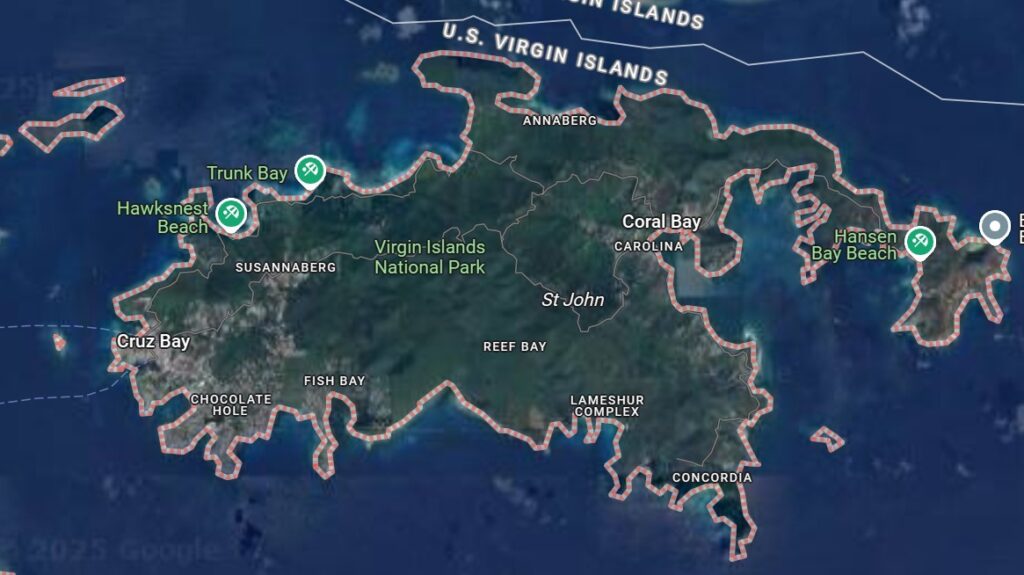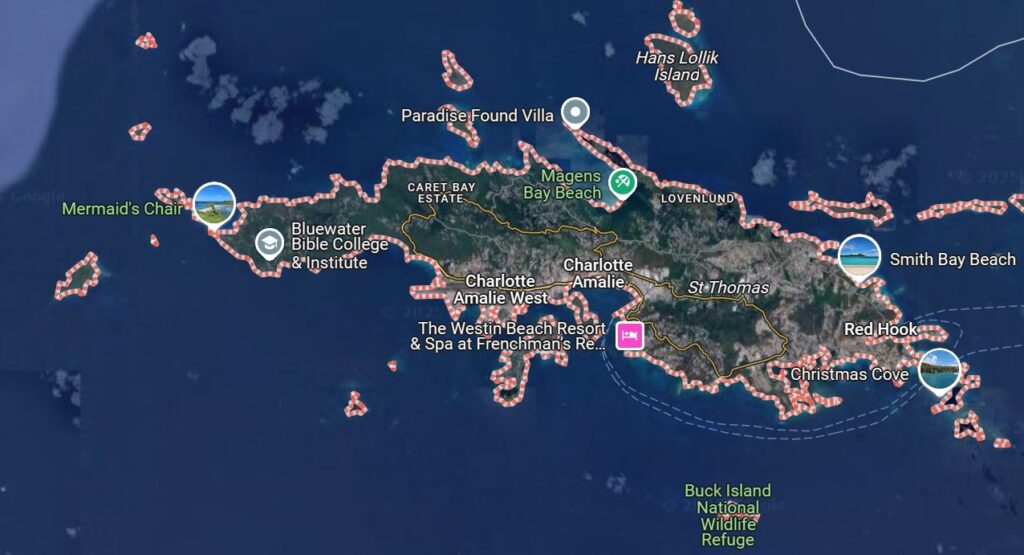The United States Virgin Islands (USVI) are a group of islands in the Caribbean Sea that are part of the United States. The USVI includes St. Thomas, St. John, St. Croix, Water Island, and many smaller islands and cays.
The first thing that you need to know is that if you are in the Caribbean and looking to shop, then this is the place to do it. St Thomas is designated duty free, but more importantly, people here are not looking to blindly profiteer like they are in most of the rest of the Caribbean.
By way of example, the ubiquitous Caribbean shirts can be bought on each and every island. They are of varying quality but the ones in the USVI are of excellent quality and will cost between $10-15 USD (depending on your negotiation skills). The ones on other islands are of lesser quality and asking prices will go as high as $100 USD with most places asking around $50.
St. Croix

St Croix is the largest of the USVI and over the years has flown the flags of Spain, The Netherlands, England, France, the Knights of Malta and Denmark.
There are two towns on the island, Christiansted and Frederiksted.
Our first foray here was a bit different from the usual cruise port. We were on a cruise from Port Canaveral and were due to get on another cruise going out of New Orleans and did not have enough time to get from Port Canaveral to New Orleans in time to get the next ship. So our alternative was to get off at St Croix, spend a couple of days, and fly to New Orleans (via Atlanta).
Our cruise ship dropped us off at the town of Frederiksted. It is the smallest of the two towns but has nice Victorian architecture and has been experiencing a renaissance of sorts after the return of the cruise ships. Frederiksted boasts a fort that once protected the island from both pirates and rival nations.
Fort Frederik, also known as Frederiksfort was built between 1752 and 1760 by Denmark-Norway to defend the economic interests of the natural deep water port of Frederiksted and to ward off pirates. It is from this fort that Danish Governor-General (Peter von Scholten) emancipated the slaves in 1848. The park surrounding the fort is now known as Emancipation Park.





The Frederiksted Pier is known for its sunsets and is a top spot for diving and snorkeling right off the pier. The area around the pier is teeming with marine life, making it an accessible and rewarding spot for underwater explorers. Additionally, the town of Frederiksted has charming streets and historic architecture that visitors can explore after a day in the water.
Having hopped off the ship with all of our stuff we negotiated a van to take us to the other side of the island to the town of Christiansted. Between the two towns are the ruins and remains of hundreds of former sugar and cattle estates.
Situated on the north shore of the island Christiansted was once the capital of the Danish West Indies and has many historic Danish buildings – typified by their buttery colour and red roofs. The main tourist thing around is the Christiansted National Historic Site.



The site consists of six historic structures: Fort Christiansværn (built between1738 and 1749), the Danish West India and Guinea Company Warehouse (1749), the Church of Our Lord Sabaoth Steeple Building (1753), Customs House (built 1840-1842), the Scale House (1856), and Government House (1747). The Danish West India and Guinea Company held slave auctions in its warehouse until 1803, when the slave trade was outlawed.






Our accommodation was right near the water, just back from the walkway that had been built along the waterfront. The waterfront was small but full of activity with all of the expected bars and restaurants.







We found a place for afternoon drinks overlooking the water and after dark even found what passed as a credible attempt at a pizza.
The downside to St Croix was the locals. We were warned both by the taxi driver and again later by the local ranger that there was a defined area that was safe for tourists and that we should not stray beyond this area.
There was a really nice looking church/cathedral thing that usually we would have ventured to, but it was distinctly outside of the ‘safe zone’. While we are both pretty adventurous travellers, but neither of us are stupid. The ‘safe zone’ felt considerably less safe the further that you got from the centre, so going beyond just for a photo of a church seemed a bit excessive.
Point Udall is also on the island and marks the easternmost point in the United States with its signature sundial monument.

St. John

St John is the smallest and most unspoilt of the USVI. It is considered to have some of the most unspoiled land and underwater habitats in the Caribbean.
We did not go to St John but it offers crystal-clear, turquoise waters that provide views of sea turtles and rays along with coral and brilliantly coloured fish within mere meters of the shoreline. Making it one of the best places to snorkel in the Caribbean.


On the land is the 5,500-acre Virgin Islands National Park (more than half of the island) that is crisscrossed by more than three dozen hiking trails. The island has dozens of virtually crowd-free, white-sand beaches.
St. Thomas

St. Thomas is the most developed of the USVI and is the shopping capital of the Caribbean. It draws hundreds of thousands of visitors each year to buy goods duty-free.
We first came here back in 2019 as part of our (me and Jimmy) 50th birthday celebrations but did not do any sort of writeup or publish any of the pictures. As with this time around, we arrived by ship and were delivered to the main town of Charlotte Amalie.


The town itself is kinda cute as it sits on a beautiful harbour surrounded by blue waters on one side and green hills on the other. The town is dotted with quaint little cottages and powdery sand beaches.
St. Thomas is home to Fort Christian, built in 1680, the fort served as a critical point of defence and government during the entire period of the Dano-Norwegian, and later Danish, administration. This ended ended in 1917 when the islands were sold to the United States. It currently holds the St. Thomas Museum, which holds artifacts and art of the Dano-Norwegian period.





St Thomas is also home to Blackbeard’s Castle (currently closed due to cyclone damage). Originally erected in 1679 (by the Danes) as a watchtower to protect the harbour it was originally called Skytsborg (meaning protection castle). It sits at the highest point of Government Hill and was great for firing on enemy ships but not so good at seeing them enter the harbour in the first place.



It is not known when it took on the name of Blackbeard’s Castle, but the infamous pirate Edward Teach (Blackbeard), sailed the Caribbean in the early 18th century. It has become part of the lore of the island that he used the tower as a lookout for his own purposes. It ended up as a private residence for many years, and was turned into a hotel, but is no longer open to the public.
The USVI are surrounded by beautiful oceans that seem remarkably clean and well managed (unlike much of the Caribbean). Even stepping off the ships at the various ports reveals teeming wildlife within the waters. As mentioned, the piers, walkways and docks have abundant sea life and the tourist operators seemed responsible and not the cowboys that we usually run into.
Without the safety concerns, I would recommend coming here for a week or two to explore the water life. The prices were not crazy (except for taxi’s) so a car hire and some accommodation in the ‘safe zone’ would make for a good trip. My sense was that most of the ‘issues’ with the locals took place after dark once the alcohol and drugs kicked in (paraphrasing the helpful ranger), and that daytime beach excursions would be fine.